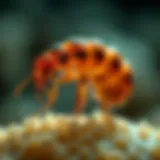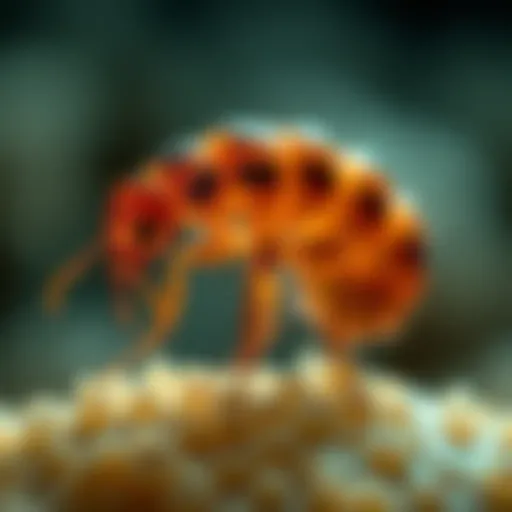Understanding Wasps in Iowa: Ecology and Management
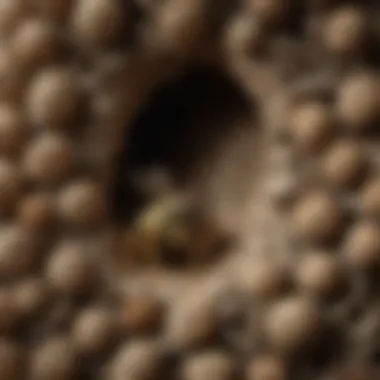

Intro
As summer days stretch into long, warm evenings, the presence of wasps tends to increase, leaving many homeowners scratching their heads in concern. Wasps can be an integral part of the ecosystem, but when they decide to set up shop in a backyard or around the house, they can create notable headaches for those living nearby. Understanding wasps in Iowa entails more than just recognizing an annoying buzz; it involves grasping their role within the food web, identifying the species prevalent in the state, and implementing management strategies that ensure safety and harmony in domestic settings.
This guide is crafted for homeowners, specifically housewives and house owners, aiming to shed light on wasps. Through a series of well-researched sections, we will discuss how to identify different types of wasps, the signs of an infestation, and strategies for pest prevention and treatment. It’s not merely about getting rid of them; it’s about understanding their behavior and making informed decisions.
Pest Identification
Detailed Descriptions of Common Pests
In Iowa, several wasp species frequently making their appearance include the yellow jacket, the paper wasp, and the hornet. Each comes with its own distinctive traits:
- Yellow Jackets: Known for their striking yellow and black markings, yellow jackets are aggressive and often nest in wall voids or underground. They tend to be more of a nuisance in late summer when their populations peak.
- Paper Wasps: These wasps are more slender and have elongated bodies, usually brownish, with yellow markings. They build open, umbrella-shaped nests, frequently found hanging under eaves or in sheltered areas. They are generally less aggressive but will defend their nests if disturbed.
- Bald-faced Hornets: While not technically a hornet, they share similarities. They are predominantly black with white markings and build large aerial nests, often in trees or shrubs. These wasps are known to be protective of their home and will fly aggressively towards perceived threats.
Signs and Symptoms of Infestations
Identifying a wasp problem early can help mitigate potential issues. Key signs include:
- Nesting Materials: Look for paper-like structures in sheltered areas, or dried mud in more subterranean environments.
- Increased Activity: If you notice heightened wasp activity around food sources or potential nest sites, they might be establishing a home.
- Buzzing Sounds: Audible activity can indicate nearby nests, especially during early morning or late evening when they are less active.
"The best defense against wasps is awareness. Recognizing their presence allows for timely intervention."
Prevention Strategies
Home Maintenance Tips for Pest Prevention
Taking proactive steps can significantly reduce the likelihood of wasps choosing your home as a nesting site. Here are some effective strategies:
- Seal Cracks and Crevices: Inspect your home for openings and use caulk to seal them. This helps prevent wasps from entering your walls and creating nests.
- Keep Food Covered: Always cover food when dining outdoors and promptly clean up spills.
- Regularly Trim Vegetation: Wasps often nest in trees or shrubs, so keeping your landscape trimmed can limit potential nesting sites.
Natural Deterrents and Barriers
There are also natural methods to deter wasps:
- Essential Oils: Scents such as peppermint can act as a natural repellent. Mixing water with a few drops in a spray bottle can help keep wasps at bay.
- Wasp Traps: Homemade traps using sugar water can lure wasps away from your space. Just remember to keep traps strategically placed, but not too near the house.
Treatment Options
Overview of Chemical vs. Natural Treatments
If prevention fails and you find yourself facing an infestation, understanding treatment options is crucial. You can choose between chemical or natural methods:
- Chemical Treatments: Products containing permethrin or pyrethroids can be effective but must be used cautiously. Follow the manufacturer’s instructions strictly.
- Natural Treatments: For a more organic approach, soap and water mixtures can suffocate smaller nests when sprayed directly.
Step-by-step Guides for DIY Treatments
For those brave enough to tackle their wasp problems independently, consider these steps:
- Identify the Nest: Wait until dusk when wasps are less active.
- Prepare your Treatment: If using a natural mixture, prepare it in a spray bottle ensuring the mix is agitated well for effectiveness.
- Approach with Caution: Wear protective clothing and approach stealthily.
- Spray: Direct the spray into the entrance of the nest, repeating as necessary since this may take a few applications.
Throughout this conversation, we’ll further dissect these elements, addressing both the intriguing characteristics and the strategies for coexistence with our buzzing neighbors. By understanding wasps in Iowa, we can navigate the challenges they present while respecting their role in our environment.
Preface to Wasps in Iowa
Understanding the intricacies of wasps is essential for residents in Iowa, especially for homeowners. Wasps are often misunderstood creatures that play significant roles in our ecosystems, yet they can present challenges that need managing. This section aims to shed light on why knowing about these insects matters, focusing on various components that affect not only the local environment but also the comfort and safety of everyday life.
Overview of Wasp Species
In Iowa, a variety of wasp species thrive, each distinct yet contributing to the same ecological web. The most prevalent species include Yellow Jackets, Paper Wasps, and Bald-Faced Hornets. These wasps differ in behavior and habitat, creating a complex intermingling of roles in both the natural world and human settings. For instance, Yellow Jackets are often considered pests due to their aggressive behavior and nesting in close proximity to human activity, while Paper Wasps tend to be less confrontational and are easier to coexist with. Understanding these nuances empowers homeowners to make informed decisions about management and prevention strategies.
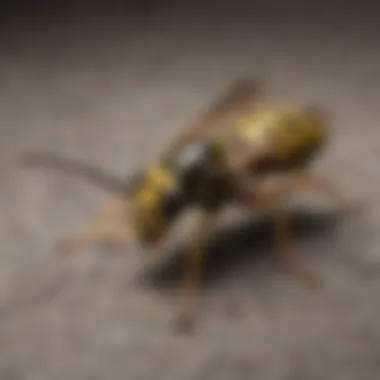

It’s also crucial to recognize that wasps are not entirely negative. They serve essential functions, such as pollination and pest control, which benefit gardens and crops, highlighting their importance beyond mere annoyance.
Importance of Understanding Local Ecosystems
Grasping the significance of local ecosystems in Iowa is akin to holding the keys to a locked door. Everything is interconnected. Wasps, despite their stinging potential, contribute to maintaining a natural balance. By understanding their behaviors and roles, we can better appreciate the environment around us. This knowledge serves not only to alleviate fears but encourages the responsible management of these insects.
Consider, for example, the role of wasps in pest control. Many wasps hunt other insects, such as aphids and caterpillars. By reducing the population of these pests, wasps indirectly support healthier gardens and crops, allowing plants to thrive and potentially reducing the need for chemical pesticides. Thus, when dealing with wasps, it becomes vital to weigh the risks against their ecological contributions.
"When you see a wasp, remember it might just be doing its job in the grand scheme of nature."
Wasp Identification
Wasp identification is crucial for a comprehensive understanding of these insects, especially for those living in Iowa. Recognizing different wasp species can significantly influence how one approaches management strategies, whether it’s for prevention or control. Knowing the physical characteristics, behavior, and habitats of various wasps can lead to better decision-making for homeowners who want to ensure their properties remain safe and welcoming. It empowers individuals to differentiate between beneficial species that might aid in pollination and pest control versus those that pose risks to humans or property.
Physical Characteristics
To identify wasps, one must familiarize themselves with their physical traits. Wasps generally have slender bodies, a narrow waist, and two pairs of wings, setting them apart from bees. They often display vibrant colors, such as yellows and blacks, which serve as warning signals to potential threats. One prominent characteristic to note is the antennae, which are long and threadlike in wasps, unlike the bushy hairs seen in many bees. Understanding these features not only aids in identification but also helps individuals respond appropriately to their presence.
Common Wasps Found in Iowa
In Iowa, several wasp species are common, each with unique traits that affect their environment and human interactions. Highlights include Yellow Jackets, Paper Wasps, and Bald-Faced Hornets. Each of these wasps plays a role in the ecosystem, and recognizing them can inform management strategies.
Yellow Jackets
One cannot talk about wasps in Iowa without mentioning Yellow Jackets. These notorious insects are easily identifiable due to their distinct yellow and black striping. Their aggressive nature often leads to conflicts with humans, especially when their nests are disturbed. Yellow Jackets tend to build their nests underground or in hidden walls, making these nests sometimes hard to spot until it’s too late.
One key characteristic of Yellow Jackets is their tendency to scavenge for food, which can be both a nuisance and an advantage. While they help control pest populations, they can also invade outdoor gatherings, drawn by sweet foods and drinks. Their distinctiveness makes them a prime subject for understanding how to manage wasp populations effectively.
Paper Wasps
Paper Wasps present a different picture. These wasps are known for their unique nests, which resemble umbrella shapes made from a papery substance. Their bodies are typically thinner and longer than Yellow Jackets, with characteristic long legs that dangle when they're in flight.
A significant part of their contribution in the ecosystem is their role in controlling caterpillar populations, which can be beneficial for gardeners and farmers alike. This aspect might make homeowners hesitant to eradicate them entirely, and understanding this can influence control measures. Their relatively docile nature means that provided one does not provoke them, a close inspection of their nests can be done without much concern.
Bald-Faced Hornets
Bald-Faced Hornets, while technically a type of yellow jacket, are distinct enough to warrant discussion. They have black and white markings, which some find striking. Nests are typically high in trees or shrubs, shaped like a football and constructed from a paper-like material.
These wasps are incredibly protective of their nests, and their aggressive behavior can make them less favorable compared to other species. However, they play a vital role in pest control, often targeting pests that can harm gardens and crops. Recognizing Bald-Faced Hornets aids homeowners in crafting targeted management strategies without compromising their ecological benefits.
In summary, understanding the different wasp species found in Iowa, along with their unique characteristics, helps homeowners navigate their presence more effectively. This knowledge empowers individuals to make informed choices regarding their interactions with these creatures, balancing safety with ecological considerations.
Ecological Role of Wasps
Understanding the ecological role of wasps is crucial for recognizing their contributions to the environment, particularly within Iowa's diverse ecosystems. Wasps are often vilified and misunderstood; however, their presence is essential for maintaining a balance in local fauna and flora. This section will delve into the unique ways wasps support the ecosystem, helping to underline their broader significance.
Pollination
Contrary to the common belief that only bees handle pollination, many wasps also contribute significantly to this vital process. When wasps roam from flower to flower in search of nectar, they inadvertently transfer pollen, assisting in the reproductive cycles of various plants. In Iowa, certain species, such as the Polistes paper wasps, are notable for their role in pollination, especially in wildflowers and garden plants.
- Types of Plants Affected: Pollination by wasps helps not just fruits but also enhances the growth of ornamental plants. This can be particularly beneficial for garden enthusiasts looking to bolster their flower beds.
- Timing: While bees are often most active in the spring and summer, some wasp species are known to forage late into the autumn months. This means they can assist in pollinating plants that bloom during the changing seasons.
"Wasps, with their often overlooked pollination behavior, are the unsung heroes of biodiversity."
Pest Control
Another vital ecological role that wasps play is pest control. Many wasps are carnivorous, feeding on various pest insects, and thus serve as natural regulators of pest populations. For example, Vespula species, commonly known as yellow jackets, actively hunt caterpillars and flies, ensuring that the numbers of these potential agricultural nuisances do not spiral out of control.
- Impact on Agriculture: Homeowners and farmers in Iowa can greatly benefit from the presence of these beneficial wasps. By keeping pest populations in check, they reduce the need for chemical pesticides, promoting healthier crop yields and landscapes.
- Biodiversity Support: Through their predatory habits, wasps help uphold the balance within food webs. Their interactions with other species – both as predators and prey – ensure the overall ecosystem remains vibrant and diverse, which is essential for the health of Iowa's natural habitats.
In summary, wasps might not be everyone's favorite insect, but their ecological contributions in Iowa are indisputable. From pollinating plants to controlling pest populations, their roles are multifaceted and significant. Ignoring these benefits could lead to a less balanced ecosystem, affecting both human livelihoods and the intricate web of life in Iowa.


Potential Risks Posed by Wasps
Understanding the potential risks associated with wasps is crucial for homeowners, especially in Iowa where these insects are prevalent. Wasps can pose significant threats not only to personal health but also to property. By grasping these risks, residents can take necessary precautions and implement effective management strategies.
Health Risks to Humans
The health risks posed by wasps should not be taken lightly. For many individuals, a single sting can lead to an allergic reaction, which may require prompt medical attention. Some might experience mild irritation, while others could face severe symptoms that may escalate quickly, such as difficulty breathing or swelling of the throat. It's important to be aware that individuals who have been stung previously are at a greater risk of experiencing more severe reactions in the future.
Consider these factors regarding health risks:
- Sting Severity: For someone who is allergic, the experience of a wasp sting can turn from a minor incident into a potentially life-threatening event. Carrying an epinephrine auto-injector, especially for those with known allergies, is highly advisable.
- Aggression During Nest Protection: Many wasps, particularly species like the yellow jacket, can become aggressive when their nests are disturbed. This can lead to multiple stings in a short time, increasing the risk of a severe reaction.
"A wasp's sting can feel like a hot poker at first, but it can also lead to complications if an allergic reaction kicks in."
Property Damage Concerns
Besides health issues, the presence of wasps can also lead to property damage. When wasps build their nests in or around homes, they can affect structural elements of buildings over time. Here are some concerns:
- Nests in Inaccessible Spaces: Nests can often be found in attics, under eaves, or within wall cavities. If left unattended, the material from these nests can cause structural damage. This is particularly the case when moisture gets trapped, creating an environment for rot and weakening the coverage of the home.
- Repetitive Nesting: Wasps may return to the same location year after year to build new nests, leading to an accumulation that can escalate into a significant infestation. It's always more challenging to manage a property already overrun by these pests.
In summary, both health risks and property damage stemming from wasp activity underline the necessity for proactive wasp management. By being informed and vigilant, homeowners can protect their families and properties effectively.
Preventative Measures
When it comes to managing wasps, preventative measures are your frontline defense. Understanding how to keep them at bay is crucial for homeowners seeking a more peaceful outdoor experience. The benefits of proactive management strategies extend beyond mere aesthetics of having a clean outdoor space; they're vital for safeguarding health and preventing unpleasant encounters with these stinging insects. Not only can effective preventive measures reduce the risk of infestations, but they can also enhance the overall enjoyment of outdoor activities. Taking the time to implement these strategies is a wise investment in comfort and safety.
Keeping Outdoor Areas Clean
A clean yard can serve as an effective deterrent against wasps. Unkempt spaces often attract unwanted pests, making your home an inviting target. Here are a few practical tips:
- Eliminate Food Sources: Wasps are drawn to food, especially sugary substances and proteins. Ensure outdoor dining areas are cleaned promptly after meals, disposing of leftovers in sealed bins.
- Seal Garbage Cans: Ensure all trash containers have tight-fitting lids to prevent wasps from foraging through waste.
- Remove Nesting Material: Wasps often search for simple materials to build nests, like paper shreds or wood fibers. Regularly clean up any organic debris, such as fallen branches and leaves.
By embracing simple cleanliness routines, you split the odds in your favor, turning your yard into less of a feast for these pesky critters.
Natural Deterrents
If you’re on the hunt for ways to keep wasps at arm's length, incorporating natural deterrents can be a game changer. These options can reduce the likelihood of a home invasion without the use of chemicals. Consider these methods:
- Essential Oils: Certain scents repel wasps. Peppermint oil is particularly potent. Mixing it with water and spraying it around your home can deter wasps' intrusions.
- Fake Nests: Wasps are territorial creatures. Hanging a fake nest can trick them into thinking the area is already claimed, causing them to steer clear.
- Herbs and Plants: Planting herbs like basil, mint, and lemongrass can discourage wasps due to their scents. These plants can double as attractive additions to your garden.
Without a doubt, taking preventative steps can significantly lessen the chances of wasps establishing residence in your outdoor spaces.
By focusing on cleanliness and employing natural deterrents, homeowners can create a less hospitable environment for wasps. Ultimately, understanding these preventative measures underlines the importance of staying vigilant, allowing for higher enjoyment of gardens and outdoor spaces.
Effective Management Strategies
Managing wasps effectively is crucial for homeowners in Iowa, not just for comfort but for safety too. The presence of these insects can induce anxiety, particularly when they nest near living spaces. Understanding effective management strategies can provide a way to alleviate these concerns and minimize risks.
When homeowners grasp the core of these strategies, they can make informed decisions on how to mitigate wasp encounters. Knowing when and how to take action can not only reduce the anxiety linked with wasps but also enhance the overall harmony in outdoor spaces. With proper management, one can create a balance between coexistence and safety.
Chemical Treatments
Chemical treatments can be a double-edged sword in the world of pest control. On one hand, they offer swift solutions, especially during an active infestation. On the other hand, these chemicals can pose risks to non-target species, including beneficial insects, pets, and even humans. Therefore, it is essential to consider the timing and method of application.
- Types of Chemical Treatments: Various products such as sprays and dust are available for eliminating wasps. These typically contain pyrethroids, which are effective yet must be applied with caution. Homeowners should follow instructions closely to ensure efficacy and safety.
- Application Timing: The best time to apply chemical treatments is during the evening, when wasps are less active and more likely to be inside their nests. Spraying during these hours can improve the effectiveness of the treatment while reducing the risk of stings.
- Safety Precautions: When using chemical treatments, it's vital to wear protective gear, such as gloves and long sleeves. Make sure to keep children and pets indoors during application and until the area is deemed safe.
"While chemical treatments may provide immediate relief, considering their environmental impact is equally important. Choose wisely."
Natural Remedies
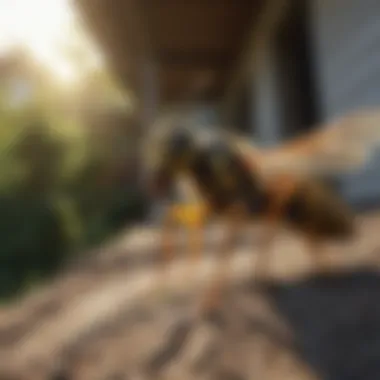

For those who prefer a more environmentally friendly approach, natural remedies can also do the trick, albeit often more gradually than chemical methods. Utilizing plants and ingredients that naturally repel wasps is not only healthier for the environment but can also be a practical solution for many homeowners.
- Essential Oils: Scents like peppermint, clove, and geranium can deter wasps. Mixing a few drops of essential oil with water and spraying it around entry points can create a barrier. This method can be particularly appealing for garden enthusiasts wishing to protect their plants.
- Soap and Water Solution: A simple blend of soap and water can effectively kill wasps when sprayed directly onto them. This method suffocates and can be used as a way to tackle individual wasps without resorting to harmful chemicals.
- Traps: Creating DIY traps using sugar water or fruit juice attracts wasps, which can help in reducing their numbers. Hanging these traps away from relaxation areas pulls them away from where people gather.
Overall, adopting the right management strategies can help homeowners in Iowa maintain peace at home. Whether opting for chemical treatments or embracing natural methods, it is essential to remain consistent and vigilant. Knowledge is power, especially when it comes to managing wasp populations effectively.
When to Seek Professional Help
When dealing with wasps, the instinct may be to hope for the best and tackle it solo. However, there comes a time when it’s essential to bring in the experts. Understanding the right moment to seek professional help can save you time, mitigate risk, and ensure safety for both you and your family. In this section, we'll dive into the indicators that suggest it’s time to call the cavalry, along with advice on selecting a reliable pest control service.
Signs of a Wasp Infestation
Not all wasp encounters signal an infestation, but here are some telltale signs that could mean it’s time to reach out for professional assistance:
- Visible Nests: If you spot nests forming under eaves, in trees, or other structures, that's not a good sign. Larger nests mean more wasps, which can lead to increasingly aggressive behavior.
- Frequent Sightings: Seeing the same type of wasps frequently in your outdoor space could indicate that they are residing nearby or that you may have unknowingly constructed a nest.
- Aggression: Wasps can be naturally defensive. If they are becoming aggressive in response to nearby activity, it's a red flag. Any stinging, especially if more than one wasp is present, can point to an infestation.
- Family Reactions: If anyone in your household experiences allergic reactions, or if there have been multiple stings on your property, it might be prudent to seek out professional help.
Remember, dealing with wasps without proper expertise can lead to dangerous situations, especially for those with allergies.
"An ounce of prevention is worth a pound of cure."
Dealing with wasps isn’t an area where you want to play it tough; this isn’t a game of chicken.
Choosing a Pest Control Service
Selecting the right pest control service can be daunting. Here’s what you should consider:
- Experience and Reputation: Opt for companies that specialize in pest control, particularly in handling wasp infestations. Reading online reviews or asking for recommendations can point you in the right direction.
- Certifications and Insurance: Ensure that the service you choose holds necessary licenses and is properly insured. This speaks volumes about their legitimacy and professionalism.
- Treatment Methods: Inquire about their treatment methods. It’s better to choose companies that prioritize environmentally friendly solutions. You want to eliminate wasps without turning your yard into a chemical wasteland.
- Comprehensive Services: Review if they offer follow-up services to prevent further infestations. A one-off treatment may help temporarily, but long-term management is key.
Ultimately, finding a pest control service that respects your home while effectively managing the wasp problem can transform an overwhelming situation into a manageable one. With these strategies, you're more likely to find a solution that suits both your needs and your family's safety.
Common Myths about Wasps
Understanding wasps can often be muddied by an assortment of misconceptions. These myths can lead to fear or mismanagement, impacting not just homeowners but the ecosystem itself. Identifying what’s true and what’s just plain false about wasps can create a more harmonious relationship with these often misunderstood insects. Addressing these common myths will not only empower homeowners but also enlighten them about the valuable roles these creatures play in nature.
Myth vs. Fact
Wasps vs. Bees
Many people often confuse wasps with bees, which is an easy mistake to make given their similar appearances. However, the differences are quite substantial. One key characteristic is that wasps tend to have a more slender body with a glossy finish, whereas bees usually possess hairy bodies that help them in pollination.
In this article, we explore why understanding this distinction is beneficial. For example, bees are generally focused on pollen and nectar, making them vital pollinators for many of our crops. Wasps, on the other hand, are predatory and often feed on other insects, thereby playing a significant role in controlling pest species. Recognizing the unique features of wasps, like their potential to reduce pest populations, can shift perceptions from fear to appreciation.
"Myth suggests that wasps are a nuisance; fact confirms their role in ecological balance."
Understanding Aggression
Aggression in wasps is another area littered with misconceptions. A key aspect to consider is that wasps generally don’t attack unless they feel threatened. Misunderstanding this behavior can lead to unnecessary panic. Recognizing that aggressive acts are defensive rather than inherently hostile can allow homeowners to coexist more peacefully with these insects.
The notion that all wasps are aggressive is misleading; in fact, many are quite docile. Understanding aggression in wasps reveals the importance of giving them space instead of provoking them. Unique behavior such as a wasp's commitment to protecting their nests emphasizes the advantages of knowing how to approach areas where wasps might dwell.
Ultimately, debunking these myths leads to more informed choices and a better appreciation for the nuanced roles these insects play in our environment.
Ending
Understanding the dynamics of wasp populations in Iowa is paramount for homeowners aiming to coexist harmoniously with nature while safeguarding their properties and loved ones. As we've explored throughout this article, wasps serve significant ecological roles, but they also present various challenges that require careful management.
Summary of Key Points
Drawing from the earlier sections, key takeaways include:
- Wasp Identification: Knowing how to differentiate between common species like Yellow Jackets, Paper Wasps, and Bald-Faced Hornets can prevent unnecessary panic and mismanagement.
- Ecological Role: Wasps contribute positively as pollinators and pest controllers, helping maintain balance in local ecosystems.
- Health and Safety Risks: Awareness of potential health risks, especially for individuals with allergies, is crucial for timely response when encounters occur.
- Management Strategies: A combination of preventative measures and effective treatments—ranging from natural remedies to chemical solutions—offers homeowners various options to deal with wasp-related issues.
- Debunking Myths: Understanding common myths about wasps can lead to more informed behaviors, reducing unnecessary fears and misperceptions.
Encouraging Responsible Management
It’s not just about eliminating wasps; it’s about striking a balance. Responsible management entails:
- Education: Stay informed about the species present in your area and their behaviors. Knowledge can empower better decision-making.
- Preventative Actions: Maintaining clean outdoor spaces can drastically reduce the attractiveness of your property to wasps. Simple actions like keeping food covered and sealing garbage can go a long way.
- Natural Solutions: Before reaching for pesticides, consider non-toxic alternatives like vinegar traps or planting certain herbs that naturally repel wasps.
- Professional Guidance: If the situation escalates, don’t hesitate to contact pest control experts. They can offer tailored strategies to manage infestations effectively and safely.
In wrapping up, understanding and managing wasps in Iowa requires a thoughtful approach that blends knowledge and action. By applying these insights and responsible practices, homeowners can foster a safer environment while appreciating the vital roles these insects play in our ecosystems.
